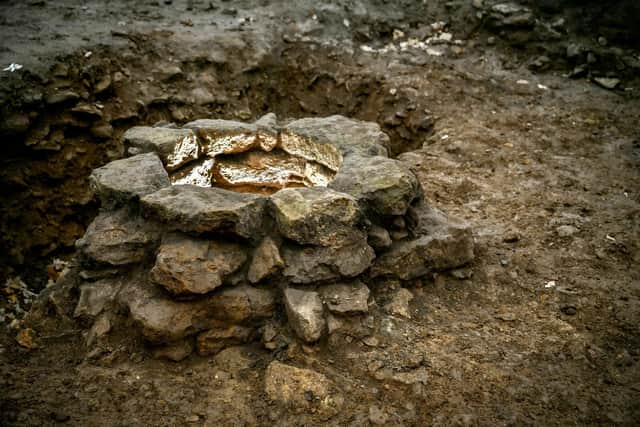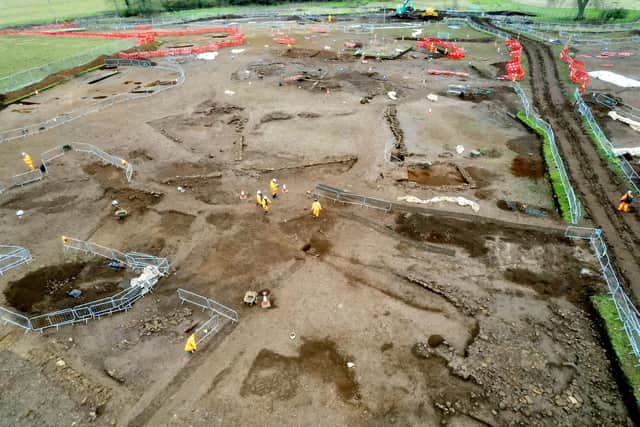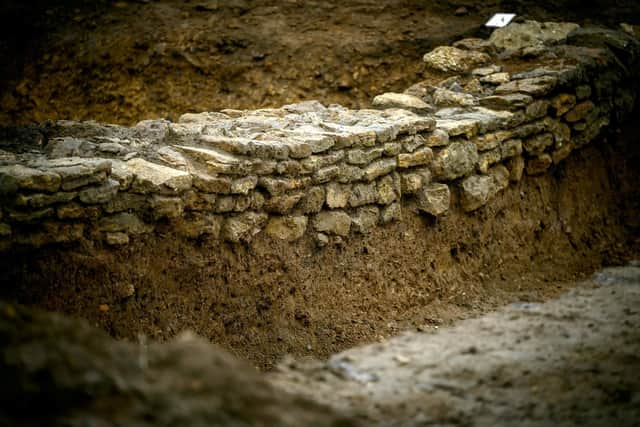Huge Roman trading town and 2,000-year-old artefacts unearthed along HS2 route
The astonishing discovery - which also includes more than 300 Roman coins - is "one of the most significant archaeological sites" uncovered during the train line project.
It was found at an undisclosed site in south Northamptonshire where a team of 80 archaeologists have been digging for the last 12 months.
Advertisement
Hide AdAdvertisement
Hide AdExperts were left stunned when they came across evidence of an Iron Age village which developed into a wealthy Roman trading settlement.


A 10m (32ft) wide Roman road runs through the site, indicating the area would have been busy with carts for trade due to its close proximity to the River Cherwell.
Over 300 Roman coins have also been discovered indicating the "significant volume of commerce was passing through this area".
As well as this, artefacts such as glass vessels, highly decorative pottery, jewellery and even evidence of make-up were also found.
Advertisement
Hide AdAdvertisement
Hide AdThe original use of the site, known as Blackgrounds after the black soil found there, began in the Iron Age when it was a village formed of over 30 roundhouses.


Site manager James West, from the Museum of London Archaeology Headland Infrastructure, said the dig had "surpassed all expectations".
He added: “This is certainly one of the most impressive sites MOLA Headland Infrastructure has discovered whilst working on the HS2 scheme.
“A particular highlight for me has been understanding the emerging story of Blackgrounds, which we now know spans multiple time periods.
Advertisement
Hide AdAdvertisement
Hide Ad

“Uncovering such a well-preserved and large Roman road, as well as so many high-quality finds have been extraordinary and tells us so much about the people who lived here."
Evidence from the dig shows the settlement expanded over time becoming more prosperous during Roman times, with new stone buildings and new roads emerging.
The layout suggests the town was split into different areas, with foundations uncovered of buildings used for domestic purposes and more industrial practices.
Blackgrounds would have been a "bustling and busy area", shown though the evidence of workshops, kilns, and several beautifully preserved wells.
Advertisement
Hide AdAdvertisement
Hide AdIn one area, the earth has been preserved with a fiery red colour, indicating it would have been used for activities involving burning, such as bread making, foundries for metal work, or a pottery kiln.
Traces of the mineral galena, lead sulphide, was also found on the site – a substance that was crushed and mixed with oil as make up.
James added: “The site really does have the potential to transform our understanding of the Roman landscape in the region and beyond.
“A particularly interesting discovery in the dig has been half a set of shackles, similar to those recently found at an excavation in Rutland.
Advertisement
Hide AdAdvertisement
Hide Ad“Unlike those uncovered in Rutland, the shackles found at Blackgrounds are not associated with a burial but may suggest the presence of either criminal activity or slave labour.”
Blackgrounds is one of over 100 archaeological sites that HS2 has examined since 2018 between London and Birmingham.
The removed artefacts are being cleaned and analysed by specialists and the details of the buildings and layout of the settlement are being carefully mapped.
Mike Court, lead archaeologist for HS2, added: “As we near the end of our archaeological field work between London and Birmingham, we have made some unprecedented discoveries, which we will continue to share with communities near our works.
Advertisement
Hide AdAdvertisement
Hide Ad“The opportunity to carefully examine a site such as Blackgrounds, and map out a long history of the site, brought to life through artefacts, building remains and roads, has enabled us to provide a more in depth understanding of what life was like in rural South Northamptonshire in the Iron and Roman Age.”
The history of the site was featured in an BBC Two documentary ‘Digging for Britain’ on Tuesday (January 11) at 8pm.
Comment Guidelines
National World encourages reader discussion on our stories. User feedback, insights and back-and-forth exchanges add a rich layer of context to reporting. Please review our Community Guidelines before commenting.
